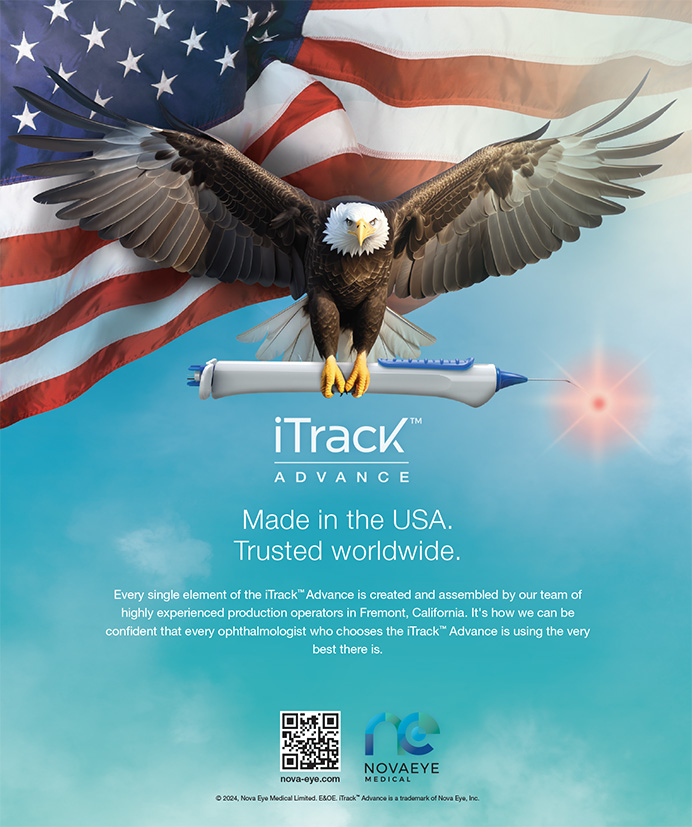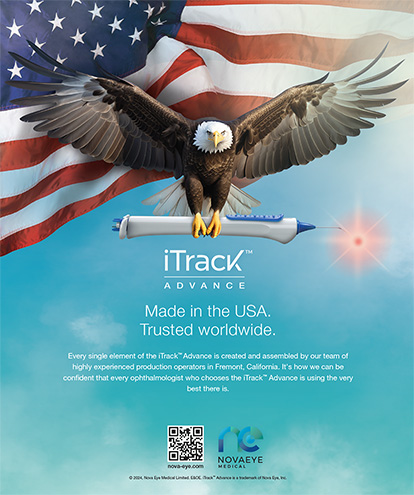
Sumit “Sam” Garg, MD
Whitestar Signature Pro
The Whitestar Signature Pro System (Abbott) has undergone software updates that improve its handling and performance. For me, the most notable change is the increased stability that results from fast, proactive responses. The machine samples IOP continuously and rapidly, testing the vacuum 250 times per second. It then anticipates changes to the pressure and makes the adjustments necessary to maintain the ideal IOP. In addition, the tubing has become less compliant. All of this results in less postocclusion surge and a more stable chamber (Figure).
Interface Improvements
Improvements have also been made to the user interface and the foot pedal. My technicians and I find the user interface to be more intuitive, and the foot pedal is more ergonomic and responsive than the previous version. The latest upgrade to the system maintains my ability to switch quickly between a venturi or peristaltic pump. Like many other surgeons, I change pump settings for different stages of cataract removal, because I feel doing so provides me with maximum control and customization of my surgical procedure. As a straight chop surgeon, I use the peristaltic pump for the initial stages of my cataract procedure to hold the nucleus during my initial chops. Then, I transition to venturi for the remainder of the case and use the vacuum-based pump for fragment removal, cortical cleanup, and thorough removal of ophthalmic viscosurgical devices. The Ellips FX handpiece (Abbott) allows me the flexibility to choose my phaco tip while providing the benefits of elliptical motion of the phaco needle.
Administrative
Other important upgrades to the system are directed toward the administrative side of cataract surgery. The cataract analysis and settings application records the relevant parameters of each case and allows me to enter notes as well. I can comment if the patient had a particularly dense cataract, Fuchs endothelial dystrophy, or other factors that might have influenced the case time or outcome. Postoperatively, I can review my parameters: how long the case took, what the turnover time was, and how much energy was used. I can compare my individual performance with that of my surgical center as a whole. This kind of benchmarking is important for improving performance and outcomes, and the surgery center manager can review and analyze information to find additional efficiencies. As in any business, the collection metrics is an invaluable tool to remaining at the top of the field, and I find that this application definitely helps.

Figure. Upgrades to the Signature system result in less postocclusion surge and a more stable chamber in peristaltic mode.
Although the system does not look dramatically different from its predecessor, the advances on the Signature Pro platform promote increased efficiency and safety in cataract surgery.
WATCH IT NOW
Sam Garg, MD, removes a dense cataract with the Catalys Precision Laser System and Whitestar Signature Pro Phacoemulsification System.

Anil Shivaram, MD
Stellaris Vision Enhancement System
Nothing exists in a vacuum. That saying resonated with me recently as I stared at an empty capsular bag during a laser cataract case. As surgical standards and technologies continue to evolve to allow more efficient removal of the lens, cataract surgeons have found themselves revisiting previously used methodologies. Vacuum-based modalities, once thought to be dangerous and unpredictable, have returned as a mainstay of cataract extraction. When coupled with the use of a femtosecond laser, the utility of vacuum truly shines. With the nucleus predivided and preconquered, the ophthalmologist’s focus turns to how best to evacuate those fragments. In my practice, the Stellaris Vision Enhancement System (Bausch + Lomb) provides me with the best platform for both laser and traditional cataract surgery by offering a number of unique advantages.
AT A GLANCE
• The Whitestar Signature Pro System samples IOP continuously and rapidly, testing the vacuum 250 times per second. It anticipates changes to the pressure and makes adjustments to maintain the ideal IOP. In addition, the tubing has become less compliant. All of this results in less postocclusion surge and a more stable chamber.
• Offering Digiflow infusion, handpiece efficiency, an optimized interface, and a dual-linear foot pedal design, the Stellaris Vision Enhancement System can adapt to the varied means surgeons use to fragment nuclei.
• The Centurion Vision System provides an I/A handpiece that can transition back and forth from a coaxial to bimanual I/A technique. The coaxial mode allows efficient removal of ophthalmic viscosurgical devices at the completion of surgery and provides easy access to cortical material in all the clock hours away from the subincisional region. Bimanual mode eases access to the subincisional cortex and allows a greater range of motion for polishing endothelial cells from the undersurface of the anterior capsule.
Vacuum or Peristaltic
For surgeons more accustomed to a peristaltic-based system, the Stellaris provides that option. I find, however, that the vacuum-based module with StableChamber tubing allows for excellent “holdability” by creating high vacuum with minimal flow. The low distensibility of the tubing in conjunction with the hyperresponsiveness of the internal sensors results in minimal postocclusion surge—a feature that is essential to control in high-vacuum settings (Figure 1). The stability of the chamber is further maintained through Digiflow pressurized infusion, which has been a feature of this machine since 2009.

Figure 1. Precise fluidic control.
My standard pattern with laser cataract cases is a six-cut pie with three central circles. The high vacuum and holdability offered by the Stellaris allow me to remove the central keystone piece. The remaining fragments are then easily mobilized, because they have been preseparated. Vacuum generation is instantaneous and does not rely on occlusion to ramp up. As a result, I do not have to chase after the remaining pie fragments, because they come straight to my tip centrally.
Cortical removal is often a stumbling block when ophthalmologists first start performing laser cataract cases, because the laser can thermally seal the cortex to the anterior capsule. I find that vacuum performs flawlessly in this setting. Using a CapsuleGuard I/A disposable handpiece (Bausch + Lomb), I start with the subincisional area and strip the cortex tangentially. The remaining cortex then provides a scaffold to the capsular bag, while addressing the potentially trickiest part of cortex first.
Efficiency
In my experience, the efficiency of the Stellaris coupled with the femtosecond laser has dramatically reduced the amount of ultrasound energy dispersed into the eye. As a result, I see much less corneal edema and better visual acuities early in the postoperative period. The dual-linear foot pedal allows me to customize small bursts of phaco energy with a yaw motion. Now, I can administer just a touch of phaco energy to clear the tip while maintaining vacuum as my primary linear variable. This technique was originally envisioned as a novel way to remove epinucleus, but I have adopted it as my primary means of fragment removal in laser cases.
For traditional cataract surgery, the efficiency of the Stellaris’ 28.5-kHz six-crystal handpiece provides fast cutting at low power settings. Having a full 150-µm stroke length allows the needle to engage the nucleus with consistency, and it is useful in both chop and divide-and-conquer situations.

Figure 2. Stellaris and Stellaris PC.
With the new Activate Plus system control software, the on-screen controls and messaging from the Stellaris unit have been streamlined and made more intuitive. Turnover time with the machine is minimal, as priming and tuning takes 3 minutes or less. In addition to improvements in the interface, the machine has a small footprint, particularly when one considers the ability to use the Stellaris PC as both an anterior and posterior segment machine (Figure 2). As the explosion in devices and tools in the OR continues, it is both efficient and cost-effective to have a multipurpose machine with a small form factor like the Stellaris PC.
CONCLUSION
While the Stellaris offers versatility in fluidics, the precision and control of its vacuum system when coupled with a laser particularly stand out to me. The Digiflow infusion, handpiece efficiency, optimized interface, and dual-linear foot pedal design create a system that can adapt to the varied means surgeons use to fragment nuclei.
In the future, I hope that manufacturers will develop better communication between the various devices surgeons use in the OR. For example, after performing a laser case, the proposed density of the nucleus and fragmentation pattern should be pushed to the phaco unit, with its settings then optimized for the laser treatment just completed. Also, being able to transmit the phaco platform’s data to an electronic health record or the cloud would allow surgeons to continue to titrate how they use phaco energy and fluidics to achieve even better results for patients.
WATCH IT NOW
In this episode of CRST Journal Club, Boris Malyugin, MD, uses the Stellaris for 1.8-mm coaxial microincision cataract surgery.

Richard Tipperman, MD
Centurion Vision System
Alcon’s latest phaco platform, the Centurion Vision System, features active fluidics and offers surgeons the ability to perform both coaxial and bimanual I/A with a single handpiece.
Active Fluidics
Active fluidics allows me to maintain a desired physiological IOP throughout surgery without relying on gravity-controlled irrigation. The balanced salt solution for infusion is contained in a pliable plastic bag that is placed within a cavity of the phaco unit. Pressure plates in the cavity compress the solution to actively control the amount of fluid being delivered to the eye at any given time based on information from advanced sensors that monitor aspiration flow rate, infusion pressure, vacuum, and other metrics. This system is designed to maintain a constant IOP and minimize postocclusion break surge.
In a laboratory study using a standardized testing protocol, occlusion break surge was lowest with the Centurion, but vacuum rise was similar compared with the Infiniti Vision System (Alcon), the Whitestar Signature Phacoemulsification System (Abbott), and the Stellaris Vision Enhancement System (Bausch + Lomb).1 By maintaining a constant pressure in the anterior chamber and minimizing surge, the device should maintain greater stability in the chambers during surgery and enhance safety.
Novel Handpiece
The Centurion Vision System introduced the Transformer, an I/A handpiece that enables me to transition back and forth from a coaxial to bimanual I/A technique quickly and safely. Both segments of the handpiece are conjoined to function in coaxial mode (Figure 1). By rotating the individual shafts in opposite directions, I can separate the front and back portions of the handpiece for bimanual mode (Figure 2). I can easily return to coaxial mode by realigning the two parts.

Figure 1. Transformer handpiece in coaxial mode.

Figure 2. Transformer handpiece in bimanual mode.
In coaxial mode, the handpiece allows me to efficiently remove ophthalmic viscosurgical devices at the completion of surgery, and it gives me easy ergonomic access to cortical material in all the clock hours away from the subincisional region. Switching the handpiece to bimanual mode gives me easier access to the subincisional cortex and allows me a greater range of motion for polishing endothelial cells from the undersurface of the anterior capsule.
WATCH IT NOW
In this episode of CRST Journal Club, Terry Kim, MD, speaks with Gary Foster, MD, about the Centurion Vision System.
1. Sharif-Kashani P, Fanney D, Injev V. Comparison of occlusion break responses and vacuum rise times of phacoemulsification systems. BMC Ophthalmology. 2014;14:96.




